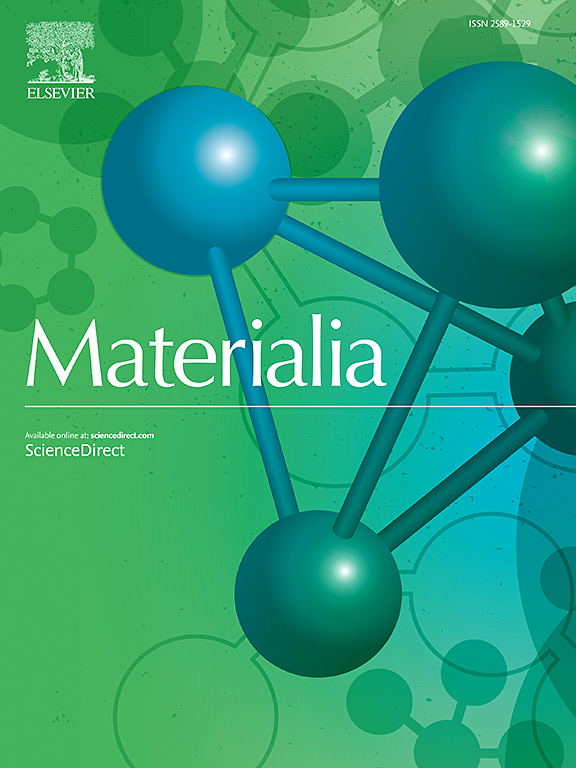硒化镉的声激波工程:结构、光学和形态演变
IF 2.9
Q2 MATERIALS SCIENCE, MULTIDISCIPLINARY
引用次数: 0
摘要
本研究探讨了声激波对硒化镉纳米粒子结构、光学和形态特性的影响,旨在提高其在太阳能电池和能量转换中的应用。CdSe以其优异的光吸收性而闻名;然而,在极端条件下,其固有的脆弱结构限制了其长期稳定性和太阳能电池性能。为了观察其结构、光学和形态性质的变化,并检验其在极端条件下的稳定性,我们对CdSe进行了压力为0.59 MPa、温度为520 K、马赫数为1.5的声激波作用。分析技术包括x射线衍射(XRD)、拉曼光谱、UV-Vis漫反射光谱(DRS)、光致发光(PL)和高分辨率扫描电子显微镜(HR-SEM)。结果显示出显著的改进,如应变速率降低和结晶度提高。晶粒尺寸由2.8 nm增大到3.3 nm。带隙从1.761 eV移动到1.741 eV, PL强度的增强表明在冲击加载条件下光吸收改善,针状形态更加均匀和清晰,这可能导致更好的力学性能。整体研究发现,CdSe结构的坚固性、光学性能的改善以及晶格应变和畸变等缺陷的减少,有效地减少了材料的降解问题。通过调整光学和形态特性来提高太阳能电池的性能。这些发现突出了使用声激波处理作为一种独特的新技术来增强CdSe的结构,光学和形态特性的新颖性。这种全面的改进使其成为提高基于cdse的太阳能和能量转换设备的效率和耐用性的有希望的方法。本文章由计算机程序翻译,如有差异,请以英文原文为准。

Acoustic shock wave engineering of cadmium selenide: Structural, optical, and morphological evolution
This study examines the effects of acoustic shock waves on the structural, optical and, morphological properties of cadmium selenide (CdSe) nanoparticles, aiming to enhance their application in solar cells and energy conversion applications. CdSe is noted for its excellent light absorption; however, its inherently weak structure under extreme conditions limits its long-term stability and solar cell performance. To observe changes in its structure, optical and morphological properties and to check its stability under extreme conditions, CdSe is subjected to acoustic shock waves at a pressure of 0.59 MPa, a temperature of 520 K, and a Mach number of 1.5. Analytical techniques are employed, including X-ray diffraction (XRD), Raman spectroscopy, UV–Vis diffuse reflectance spectroscopy (DRS), photoluminescence (PL), and high-resolution scanning electron microscopy (HR-SEM). Results show significant improvements, such as lower strain rates and enhanced crystallinity. The crystallite size increased from 2.8 to 3.3 nm. The bandgap shifts from 1.761 eV to 1.741 eV, and enhanced PL intensity indicates improved light absorption, and a more uniform and clearer needle-like morphology under shock-loaded conditions, which may lead to better mechanical properties. The overall study finds that CdSe structural robustness, improved optical properties, and reduced defects, such as lattice strain and distortion, effectively reduce the material's degradation issue. The optical and morphological properties were tuned to improve the solar cell performance. These findings highlight the novelty of using acoustic shock wave treatment as a quite new technique to uniquely enhance the structural, optical, and morphological properties of CdSe. Such comprehensive improvements make it a promising approach for increasing both the efficiency and durability of CdSe-based solar and energy conversion devices.
求助全文
通过发布文献求助,成功后即可免费获取论文全文。
去求助
来源期刊

Materialia
MATERIALS SCIENCE, MULTIDISCIPLINARY-
CiteScore
6.40
自引率
2.90%
发文量
345
审稿时长
36 days
期刊介绍:
Materialia is a multidisciplinary journal of materials science and engineering that publishes original peer-reviewed research articles. Articles in Materialia advance the understanding of the relationship between processing, structure, property, and function of materials.
Materialia publishes full-length research articles, review articles, and letters (short communications). In addition to receiving direct submissions, Materialia also accepts transfers from Acta Materialia, Inc. partner journals. Materialia offers authors the choice to publish on an open access model (with author fee), or on a subscription model (with no author fee).
 求助内容:
求助内容: 应助结果提醒方式:
应助结果提醒方式:


